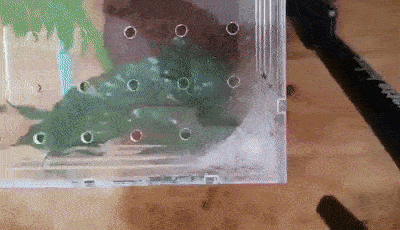Raising Spiderlings
Juvenile jumping spiders are often called spiderlings or slings, I'll refer to them as slings here.
Spiders should be provided with spaces to lay their eggs. I often provide a variety of ledges and paper pouches for them to chose from in their enclosure.
Normally their mother will guard the eggs until they hatch (after 2-6 weeks) and then guard the spiderlings until they are old enough to leave the nest. During this time they should not be disturbed though it's OK to offer the mother food (though it's unlikely she'll take it) and the environment should be kept humid. Be careful when providing water as spiderlings may drown. A very fine mist can be released into the enclosure with a spray bottle.
Soon they will leave the nest, though they will do so slowly and unevenly. If you are worried about them escaping you can put the enclosure inside a mesh enclosure such as those typically used for raising butterflies. Or you can very carefully move the sac with the spiderlings inside of it into an escape proof enclosure.

Thanks to Maria Krecina for this illustrative example of removing a sac
Separating them can be a challenge. It can be hard to decide when to do it, but you should wait as long as you can, as they are easier to feed and hydrate communally. Water should be provided as a fine mist once a day and they should be fed fruit flies every other day.
I raise them communal in 32 oz. deli cups. I cut a tiny hole in the side and cover it with duct tape and use this to provide food and water, so I don't have to open the lid. Opening the lid increases risk of slings getting crushed or escaping.


The easiest way to get fruit flies into this hole is to use a funnel.
I typically separate once it looks like some spiderlings are much larger than their siblings, as this is usually when cannibalism becomes an issue. I take out the largest ones and house them in deli cups (see the section on simple deli cups under Spider Enclosures). A good way to separate them is to utilize a pop-up tent, opening the large communal deli cup inside the tent and then carefully moving them with a bit of paper.
Eventually they are all separated. In the deli cups I provide fruit flies every other day via a funnel and water every three days.
[attach picture]
As the spiderlings grow they tend to be a bit messy and detritus will collect on the floors of the deli cups. You can just throw the lid away and replace it with a new one.
They will molt many times, and eventually when they are around the size of a housefly, I switch to feeding them houseflies. They can typically take them even if they are smaller than the fly they are hunting. Once they are eating houseflies you don't have to feed them as often, only every 4-5 days.
Unwanted and Infertile Eggs
If you do not intend to raise spiderlings, I would recommend against keeping a wild-caught female spider as they may have been fertilized. You can take the eggs away but I strongly recommend against it as many spiders become "depressed" after that. Some spiders have died after their eggs were taken away. If you have to, I recommend removing the eggs from the sac carefully and placing them in the freezer to kill them, then putting something similar looking into the sac and putting it back into the enclosure. Some spiders may accept this. Either way, the spider may refuse to eat for up to a month after eggs are taken away, be patient and do not try to force food on them.
Unmated female spiders will also lay eggs and I also highly recommend leaving them alone with their sac. Phids will typically lay 1-3 infertile clutches, guarding them for a week, not eating or leaving, before abandoning them.